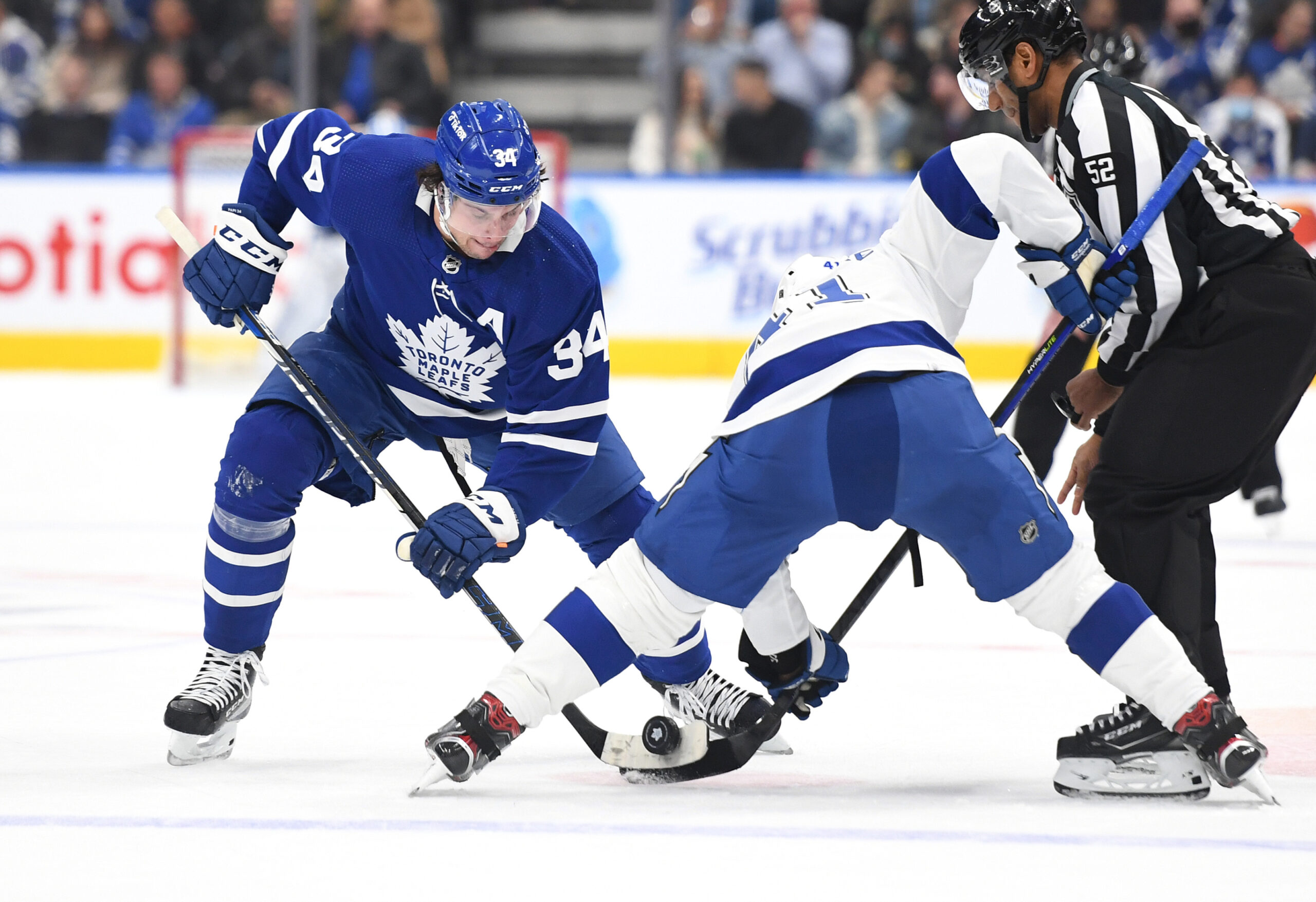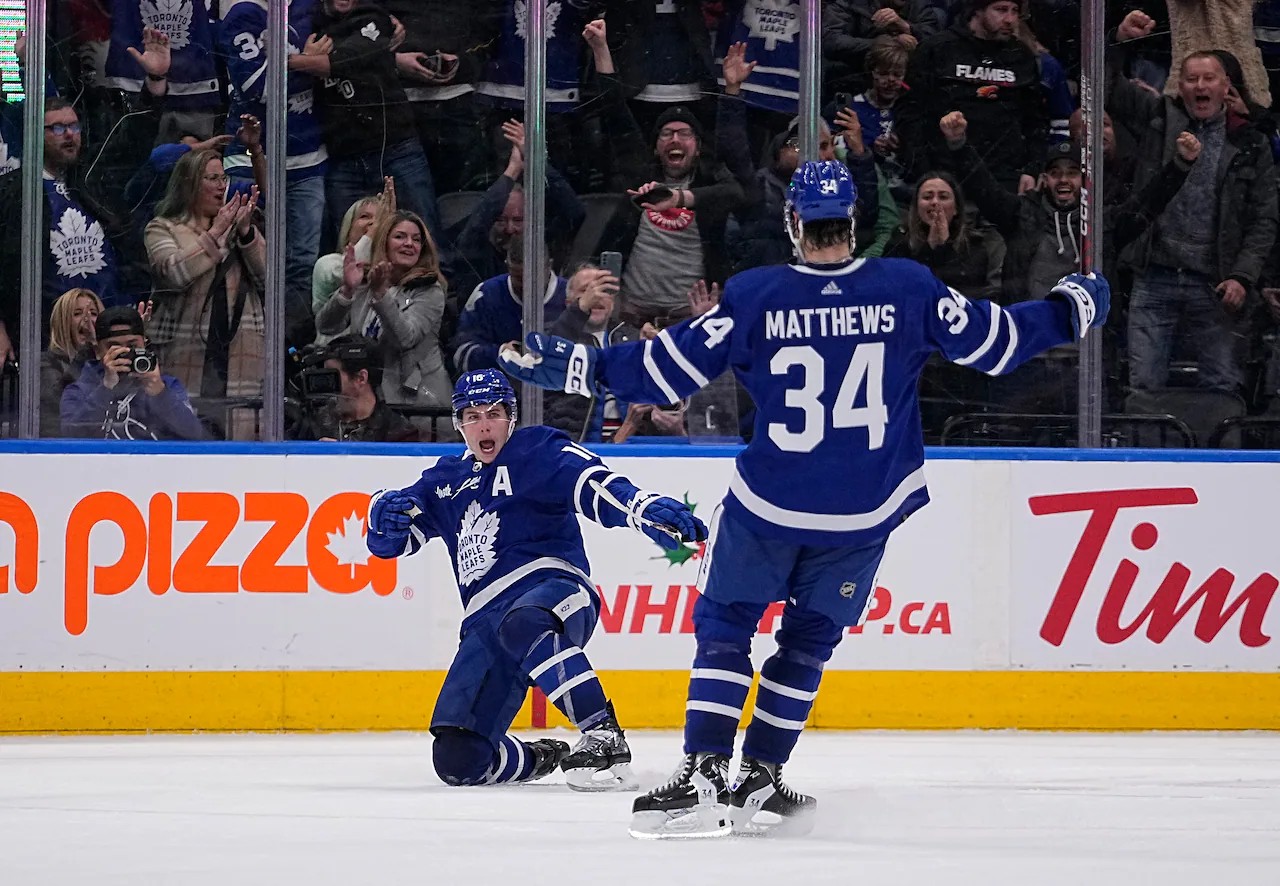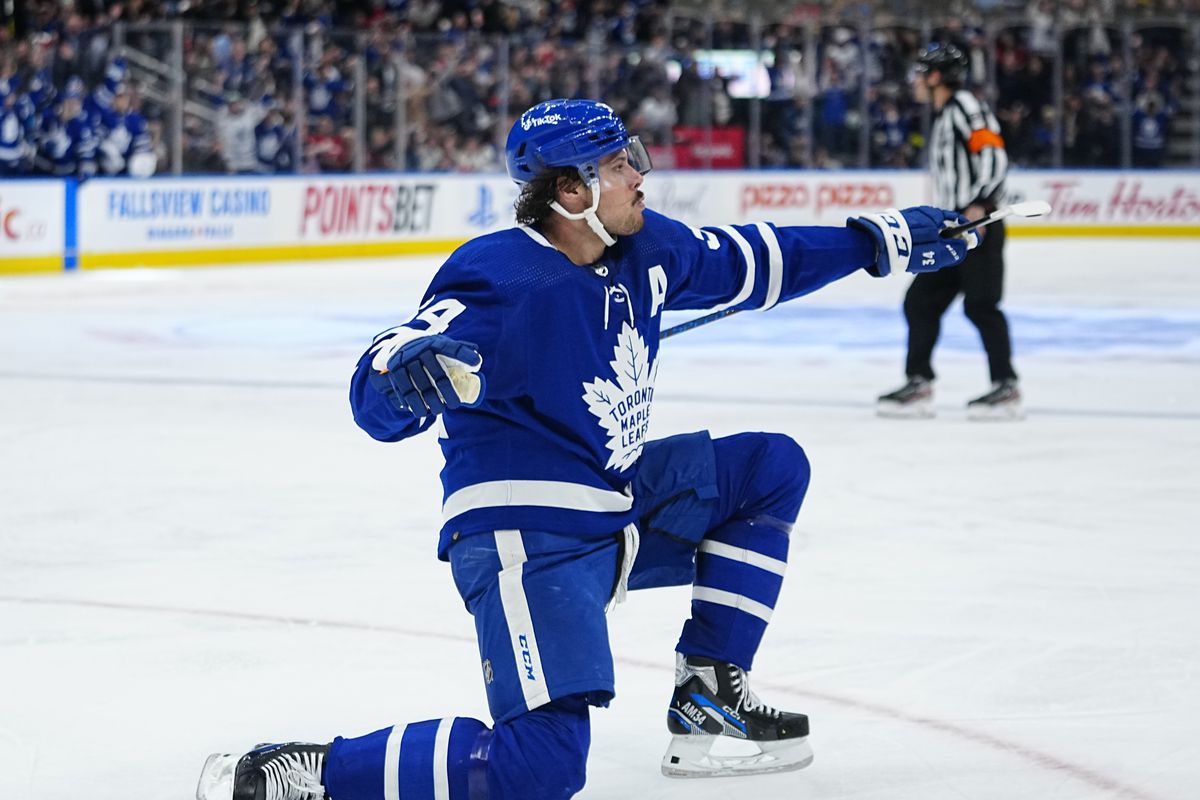In the end, this contract negotiation was all about what Auston Matthews wanted.
As an elite player at a premium position and a pending UFA in his mid-20s, he can more or less write his own cheque. It’s clearly not a player or position a team can readily replace.
It has been reported that Matthews held firm on signing a shorter-term deal – which is obvious given he only signed for four years – even though the Leafs pushed for more. Realistically, the club never held any leverage to really push back, and trading Matthews away would have opened a whole can of worms. As Brad Treliving recently experienced with Calgary, when star players want out, even if talent is acquired in return, a team will feel the pain of losing a true star.
The club did hold leverage when Matthews was a restricted free agent signing his second NHL contract. They didn’t win on term or annual average then, and now with Matthews holding all the cards, the result was predictable. Despite all the media fearmongering about what would happen surrounding Matthews’ contract talks with Kyle Dubas gone — there was lots of doomsday talk — he ended up following the path he was expected to take, whether Treliving or Dubas was in charge.
On face value, it’s a bit of a tough deal to swallow: four years and $13.25 million per season, making him the highest-paid player in the league. Almost all the deal is structured in signing bonuses, too:
Auston Matthews 4 year $13.25M Cap Hit Deal:
Year 1 775K Salary, $15.925M Signing Bonus
Year 2 775K Salary, $14.425M SB
Year 3 900K Salary, $10.18M SB
Year 4 900K Salary, $9.12M SBIncludes full No Move Clause
Rep'd by Judd Moldaver @wassermanhockey https://t.co/WCnBMxh3qD
— PuckPedia (@PuckPedia) August 24, 2023
The short term is frustrating for the obvious reasons: He didn’t commit long-term, and he has positioned himself for another big contract years from now when the salary cap will be higher.
The annual average is somewhat frustrating because he’s the highest-paid player in the league but he’s not the best player in the league. I don’t think anyone familiar with the NHL would seriously argue that anyone besides Connor McDavid is the best player in the league. Nathan MacKinnon is the current highest-paid player in the league, and chips on the table at playoff time, he has dwarfed Matthews’ production with 100 playoff points in 77 playoff games (and a Cup) compared to 44 points in 50 games for Matthews. It is not even remotely close.
The above lens is also not exactly the best way to view or evaluate a contract. The percentage of cap space a contract is taking is a baseline agents use in contract negotiations, along with player comparables, to establish value while adjusting for inflation and a moving salary cap limit.
Earlier this summer, I wrote:
“Over the past 10 seasons – not including the Alex Ovechkin mega-long deal that you couldn’t even sign in this day and age – the top contracts in the league have averaged roughly 16.3 percent of the league’s cap. At a cap ceiling of $83.5 million, that’s roughly a $13.6 million contract, and while that is a notable jump from Nathan MacKinnon’s current high of $12.6 million, it’s a palatable range for a max-term contract that holds well on a flat cap and should age well as the cap rises. It takes Matthews through the rest of his 20s and early 30s.”
At a $13.25 million cap hit with an $83.5 million salary cap, Matthews comes in at roughly 15.9 percent of the cap. To some degree, he did shave some off the top there. However, the cap hit comes into effect next season – not this upcoming one – and the salary cap at that time is projected to go up to $87.5 million or possibly even $88 million. At $87.5 million for 2024-25, Matthews’ new contract occupies 15.1 percent of the cap.
While McDavid did sign for eight years, his cap hit percentage was 16.67 percent. Nathan MacKinnon, who also signed for eight years, was at 15.27 percent. In that sense, he did fall in line under those two players.
It will feel like semantics, but Matthews did take a haircut based on those percentages. Additionally, it’s obvious to everyone that he easily could command over $15 million or possibly $16 million on the open market as an unrestricted free agent. Some team would have offered him a blank cheque to change their franchise.
Again, that’s why this deal was really lost years ago when the Leafs were weak in negotiations when he was a restricted free agent and they had real leverage to use. Teams around the league try to “win” on the RFA negotiations, achieve team success, and then pay the piper. The Leafs paid upfront —not just with Matthews, but across the board — won nothing, and are now paying up again.
A max-term deal would have been a real accomplishment for Brad Treliving. It would have emphatically set the tone for the organization moving forward having the face of the franchise committed for the rest of his prime while putting contract discussions aside for nine years, with the focus squarely placed on winning. It would also set the bar for future contract discussions with William Nylander and Mitch Marner, which is also important. We have seen the domino effect before with how all of their contract situations are intertwined.
Instead, Matthews became the first player in the salary cap era to sign two deals for over $10 million per season and under seven years in term.
No other player in the league is doing this. Connor McDavid and Nathan MacKinnon are both signed to eight-year contracts. In fact, every player in the top 10 in terms of annual average cap hit is on a max deal (either eight years or seven years depending on if they signed somewhere as free agents, as Artemi Panarin and John Tavares did). Except for Matthews and Marner.
As a fan, it is disheartening. All other teams benefit from locking in top players below market value and enjoying the cap flexibility it brings. For the Leafs, they generally haven’t exploited that benefit in this era. Making matters worse, those players commanding top dollars and holding the organization’s feet to the fire at negotiation time are nowhere to be found when the team needs them the most in elimination games (two players, in particular, to be clear).
If a star player squeezes every dollar but is full value when the chips are down, most fans will be A-okay with it. For Matthews, not only did he not score a single goal in the second round, but his production in the regular season was disappointing by his standards. His goals per game was its lowest in four years. He finished 17th in points per game. Those are great numbers in general, to be sure, but not “highest-paid player in the league” numbers.
He did battle injuries, and it clearly impacted his ability to shoot. But injuries have been an issue for pretty well his entire career. He has played just one full season since entering the league, and that’s potentially where this contract could get even more interesting.
The flip side of a four-year term

Matthews has positioned himself for one more big payday in the summer of 2028 right before he turns 31. The flip side is that if he continues to battle injury every year and his wrist seemingly never heals, coinciding with his play naturally declining as he gets older, why would the organization pay up at that point?
What if the team continues to disappoint come playoff time and they win absolutely nothing through the entirety of Matthews’ 20s? Is the club then going to pay him deep into his 30s? In such a scenario, I’m sure Matthews would seek the long-term eight-year deal that he has absolutely avoided at all costs so far.
Beyond the pressure of carrying the title as the highest-paid player in the league while playing for its most scrutinized team, Matthews is going to need to put up elite numbers to position himself for one last big payday. Over the years, I bet a lot of teams that signed star players to monster long-term deals would have liked the ability to get out of those contracts in the player’s early 30s.
Of the top 20 scorers in the league last season, only three – Erik Karlsson, Sidney Crosby, and Artemi Panarin – were over the age of 30.
In a perfect world, Matthews performs like the player we all know he is – an elite 1C that dominates the entire ice and scores goals like nobody else – but if injuries persist, his numbers decline, and the Leafs win nothing, they are actually set up quite nicely to either walk away cleanly or even trade him in the final year to try to cash in to some degree.
On its face value – highest paid player, short term – the contract is all kinds of disappointing. But in terms of his cap hit as a percentage against a (expected) rising cap and an option to renegotiate with a player who hasn’t yet shown he can stay healthy or come up big in the playoffs when it matters in his early 30s, there are a number of silver linings to appreciate.
Final thoughts on the Matthews contract and the Nylander, Marner negotiations to follow

At the end of the day, the Leafs could not afford to lose Matthews under any circumstances, and while tons of players have shown up at training camp or even started the season without a contract before signing a big extension (David Pastrnak signed in March last year!), it would have been a disaster in this market.
Just last week, Jeff O’Neill went on a rant positioning and comparing Matthews’ situation to John Tavares’ back with the Islanders. Imagine if the Leafs went into the season without a deal signed; it would have been a neverending storyline. Getting this done, taking the biggest question mark off the table, and shifting the focus to the William Nylander contract is a win for Brad Treliving.
Matthews was always the player the Leafs were going to have to bend over backward to accommodate. They can’t replace a 1C. They have a 33-year-old John Tavares, a few other potential centers in Max Domi and Calle Jarnkrok, and some young players like Fraser Minten and Pontus Holmberg. It would be pretty dire, and as we saw some years ago pre-Matthews, acquiring centers is very difficult. The best center UFAs next year are Elias Lindholm, Chandler Stephenson, and Ryan Hartman. Compare it to the Leafs signing quality wingers like Tyler Bertuzzi and Domi to simple one-year deals this summer. That is a much easier position to find value readily available.
It also puts to bed some of the Kyle Dubas nonsense in terms of needing Dubas around to sign an extension with these players. That was clearly never an issue, and the players all seemingly have good relationships with Brendan Shanahan, as we expected they would (he has been the man in charge since the very beginning).
Now the hard part starts: negotiating with Nylander, who has reportedly asked for more than where his comparables should slot him, and who the Leafs will have to be much firmer with in negotiations compared to Matthews. Is he going to look at this Matthews contract and say, “I’m not worth $4 million less than him?” He is an excellent player, but he is not a write-his-own-cheque player.
At some point, there will have to be a cutoff, and the Leaf really can’t justify losing Nylander for nothing. They will either have to find common ground or move on, but the longer this goes on – and the summer is almost over – the less value they are going to fetch in any sort of trade. At this time, the possibility really seems off the table, and it’s really just about finding a deal that works for both sides.
Next summer, Mitch Marner negotiations will begin, which is a whole other kettle of fish. Last time around, his camp compared Marner to Matthews, which is a ridiculous comparison considering the goal-scoring prowess of Matthews and the premium position he plays by comparison.
If Treliving can come to terms with Nylander, as we have said a few times now, it will give them some leverage to push back on Marner. That would bring both Matthews and Nylander under contract to go along with a still very productive John Tavares, a hopefully emerging young player in Matthew Knies, and potentially a very good top-six winger in Tyler Bertuzzi (or the ability to sign wingers with the selling point of playing alongside Matthews). They can’t let Marner hold them over a barrel again.
For now, Matthews is signed, sealed, and delivered. If the cap rises as expected – and he plays to the level he is capable of – it is going to age well. If it doesn’t go as expected, they have the ability to either get out of it altogether cleanly or renegotiate on different terms.
This is what Matthews wanted, and the Leafs really had no choice but to oblige. It’s one less headache, and it gives the Leafs an elite player under contract through the rest of his 20s. It could be better, but it could also be much worse. The real test, though, comes with the next two negotiations.






























![New Leaf Anthony Stolarz on the opportunity in Toronto: “In Florida, I knew my role as a backup… Now, [Joseph Woll] and I are competing for starts… As a goalie, that’s all you can ask for” Anthony Stolarz, Stanley Cup win, now Maple Leaf](https://mapleleafshotstove.com/wp-content/uploads/2024/07/anthony-stolarz-sc-100x70.jpg)
